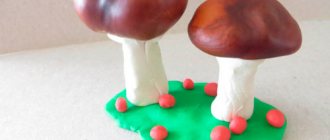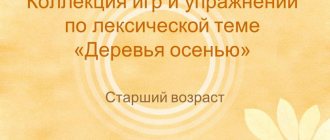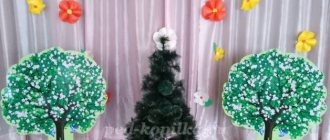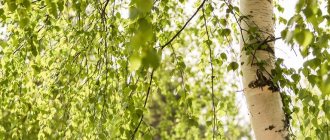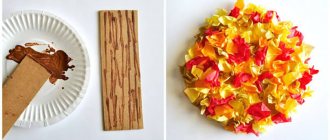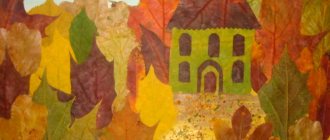Inclusive drawing lesson “Trees in Autumn” for pupils of the senior group of preschool educational institutions
Modern society pays great attention to developing children's ability to think creatively.
Preschool age is considered the best stage for the development of creative potential, the capabilities of any child, and his mastery of various jobs.
According to statistics, in our country children often suffer from visual impairment. Defects in the visual organs affect not only visual functions, but also cause disturbances in the mental processes and motor sphere of the child. Children with visual impairments cannot perceive the world around them in all its diversity, since the system of sensory standards is distorted. When visual functions are impaired in preschool children, a number of deviations arise that are associated with a decrease in cognitive processes (perception, imagination, visual-figurative thinking), changes occur in the development of speed and coordination of movements, their accuracy, tempo, fine motor skills, and mastery of social experience is limited. Children experience significant problems in color discrimination when determining color saturation, shades and lightness of objects, and the size of three-dimensional objects [1].
Typhlopedagogy as a section of special pedagogy is developed on the basis of the principles of humanistic education and taking into account the unique development of children and adults with visual impairments. Complete or partial loss of vision forms the uniqueness of the emotional-volitional sphere, character, and sensory experience.
The blind and visually impaired have problems in playing, learning, and mastering professional activities. In some cases, the unique character and behavior of people with visual impairments affects the development of their negative character traits: uncertainty, passivity, and a tendency to self-isolate; in other cases – increased excitability, irritability, turning into aggressiveness [2].
Inclusive education is aimed at creating conditions in a preschool educational institution that make it possible to remove the barriers that prevent children with disabilities from being full participants in the modern preschool educational process. Inclusive education can give them the opportunity to learn and develop in the environment of ordinary preschoolers. A characteristic feature of inclusive education is that children with disabilities have easy access to similar requirements, which provide them with the opportunity to proportionally, with the same rights as other children, join the educational system.
Inclusive (French inclusif - including, from Latin include - I conclude, include) or included education is a term that is used to describe the inclusion of children with special needs in the educational process of a mass nature, that is, aimed at the majority.
Inclusive education is designed to create a sphere in preschool educational institutions in the absence of barriers, which allows children with narrow abilities to feel themselves to be full participants in the modern preschool educational process. The main goal of preschool educational institutions when introducing inclusion and inclusive approaches is to create the necessary conditions for harmonious interaction between children of the inclusive group and ordinary preschoolers [3].
A child with visual impairments has every opportunity for a high level of psychophysical development and full knowledge of the world around him, relying on a intact analytical network. In the conditions of special training, adequate techniques and methods of using auditory, skin, olfactory, vibration and other analyzers are formed, representing the sensory basis for the development of mental processes. Thanks to this, higher forms of cognitive activity develop, which are leading in the compensatory restructuring of perception.
The visually impaired have a concrete opportunity to become acquainted with phenomena and objects, and in addition to this, there is the presence of plastic orientation and use of their vision. Vision remains their main analyzer. However, their visual perception is only partially preserved and is not entirely complete. Their overview of the surrounding reality is narrowed, slow and inaccurate, therefore their visual perception and impressions are limited, and their ideas have a qualitative originality. For example, a visually impaired person has impaired color perception, the color characteristics of the perceived shade are depleted.
The understanding of objects and their displays is affected by non-compliance with oculomotor functions, which gives rise to problems in registering gaze, tracking dynamic changes, and assessing linear and relative quantities.
Corrective work for such disorders is aimed at using special techniques and methods for observing phenomena and objects based on hearing, touch, and smell, which allows children to form complex synthetic images of reality.
The vanishing vision of a visually impaired person plays a significant role in its formation, training, work and social adaptation. Therefore it must be carefully guarded.
Sensation plays a huge role in the perception and comprehension of the surrounding reality for the blind and visually impaired. Tactile perception provides a complex of various sensations (touch, pressure, movement, heat, cold, pain, texture of material, etc.) and helps determine the shape and size of a figure, and establish proportional relationships. Various sensations perceived by the nerve endings of the skin and mucous membranes are transmitted to the cerebral cortex in the department associated with the work of the hands and fingertips. This is how the blind and visually impaired learn to “see” with their hands and fingers.
Along with touch, auditory understanding and conversation are of great importance for the blind and visually impaired in various types of work. The corresponding response from the elder activates sensory perception in children. The success of individuals with visual impairments mastering different types of work: real work, video games, work, training - depends on the highest degree of formation of visual-figurative views, plastic thinking, and spatial orientation. The success of persons with visual impairments in mastering various types of activities (subject, game, work, educational) depends on a high level of development of visual-figurative concepts, spatial thinking, and spatial orientation.
Teaching activities are focused on the harmonious formation of children to the extent that this makes it possible to achieve the degree of vision pathology in any individual case, as well as the psychological and physiological formation of children. Teaching activities are based on teaching and learning projects in numerous kindergartens, based on which special programs are developed.
The process of correctional activities with a visually impaired child is based on play. Invaluable support is provided in this project by deliberately formed play work with the goal of knowing the surrounding society and implementing targeted correctional work, generating in the child the desire to show himself his own creative inclinations, his own skills. Fun is considered to be a reflection of this knowledge and views about the surrounding society that children with visual impairment have developed. If you gently create a variety of fun activities, taking into account the range of interests of each child, then every child will be able to show their own creative potential and realize it for themselves. Fun generates a counter-response in children - dynamism, the creation of their own and a real society, gives pleasure, is intended to satisfy urgent important needs, and the implementation of creative functions.
The main rule of the lesson according to the formation of creative possibilities is gradualism and step-by-step, in this case there is from ordinary to complex. Domestic and foreign psychologists (L. S. Vygotsky, A. V. Zaporozhets, L. A. Wenger, etc.) emphasized that it is important not only to enrich preschool children with knowledge and experience, but also to develop their mental processes and functions. After all, this is of considerable importance for the development of children's creative activity, since the characteristic features of preschool age are fantasy, imagination, and non-standard thinking [4].
The creative process begins with a keen interest in the actions of society and implies the ability to contain emotions in memory and become aware of them. And in children with vision pathology, creative work is in direct connection with the richness and diversity of their past skills, due to the fact that this skill presupposes the basis from which imagination arises. In correctional services with preschoolers, the child’s visual skills are regularly enriched by the formation of specialized circumstances that provide them with a more absolute understanding of the reality around them, awaken their emotions and develop their psychological sphere. At the same time, the natural potential of children increases. Specially organized play observations, excursions, experiments, viewing of paintings and various objects of the surrounding world are carried out to broaden the horizons and creative abilities of children [5].
Visual work plays a significant role in the multifaceted formation and education of a child with vision pathology and is intended as a significant tool for correcting and compensating for visual impairment.
With the support of vision, we determine the shape, size, color of objects, their plastic location and level of distance. The functions of vision are considered: visual intensity, color discrimination, field of vision, type of vision, oculomotor functions. With low vision, insufficiently clear, unstable, and sometimes incorrect ideas of perceived objects are formed, children find it difficult to establish cause-and-effect relationships, and their level of emotional perception of the environment decreases.
Drawing classes have an extremely beneficial effect on children: visual understanding and interest are formed, concepts are created, motor skills and spatial organization are corrected. At first glance, it seems that children with disabilities and the development of creative abilities are incompatible concepts. Research has found that, in comparison with a strong child, the degree of self-esteem of preschoolers with vision pathology is less stable. In visually impaired children, the development of an assessment of their own abilities and an understanding of their own shortcomings begins already in preschool age. Studies have shown that, compared to healthy children, the level of self-esteem of preschoolers with visual impairments is lower.
In order to attract a child to drawing using a non-standard artistic technique in his free time, it is preferable to create in a group a developing spatial environment aimed at activating various creative manifestations of the child and equipped with various aids and materials used: stencils, presses, a template, small markers, felt-tip pens, various caps, corks, figures, etc. In introducing children to non-traditional artistic techniques of depiction, three stages can be roughly distinguished:
Stage 1 – development in children of positive emotional interest in the activities and results of drawing;
Stage 2 – teach children how to properly hold and use drawing tools;
Stage 3 – consolidate the skills and abilities of working in a variety of image techniques.
Non-traditional image techniques show large abilities to a child with visual impairments in order to formulate various feelings, promote the manifestation of creative components in expressive work, and have a beneficial effect on the formation of personality, action and communication. The creativity of children is determined by their rich and intelligent imagination, which is sometimes more significant for them than information from life, and by their ability to focus entirely on what worries them right now. Children's creativity is a whole new world that evokes deep interest and a desire to expand it, give everything necessary for development and seriously understand its problems.
L. S. Vygotsky considered creative work to be a similar activity of a person that forms something new, everything without exception will also become a given unit formed by creative work, some thing of external society, or a notification of third-party intellect, or emotions, living and revealed only only in the person himself [6]. Creative abilities include such qualities of the mind as observation, the ability to compare and analyze, combine, find connections and dependencies, patterns, etc.
Forming the creative potential of children is a very serious and difficult matter; it can only be realized by paying attention to the children, only by understanding their needs, range of interests and passions.
It is important to provide the child with as much self-sufficiency as possible and to stimulate his creative process. Preserve any necessary undertaking of the child, especially if it expresses intelligence, innovation, and resourcefulness. It is very important for any child to find a role in order to demonstrate their own abilities, capabilities, and passions. The importance of visual activity as a powerful means of aesthetic and moral education of a child has been repeatedly noted in the literature (L. S. Vygotsky, G. G. Grigorieva, E. I. Ignatiev, T. S. Komarova, N. P. Sakulina, E. A. Flerina, etc.). Even a cursory review of the functions and processes involved in the development of visual activity shows its importance for the development of the child’s personality, the disclosure of his individual perception of the world, the formation of ideas about objects and phenomena, and the expansion of knowledge about their interrelation and interaction [7].
In the process of perceiving and displaying the world around them, a child with visual impairments may experience certain difficulties. A. G. Litvak, V. A. Feoktistova, O. I. Egorova, V. A. Belmer and others note that this category of children has an impoverished stock of ideas, disturbances in form, proportions, and the ability to highlight characteristic informationally important details occur. and signs, both in design and color. In the process of perceiving and displaying the world around them, a child with visual impairments may experience certain difficulties. A. G. Litvak, V. A. Feoktistova, O. I. Egorova, V. A. Belmer and others note that this category of children has an impoverished stock of ideas, disturbances in form, proportions, and the ability to highlight characteristic informationally important details occur. and signs, both in design and color. In addition, there are problems associated with insufficiently developed fine motor skills and motor coordination; visual impairment is manifested in the imperfection of working with such traditional visual materials as brushes, paints and pencils, which require clarity and precision of the hand and eye [8].
The teacher’s task is not to scare away a visually impaired child from the process of drawing, not to support the mood associated with the state of vision, but to introduce him gradually into the bright world, considering even the smallest step into the world of art as a huge achievement.
Fine art is a special activity, since its result belongs to the sphere of spiritual, personal self-expression. By building relationships with an adult who speaks the language of art, the child gains new experience that he can bring to life. The main thing is to create a space of security and trust. This space for the child temporarily becomes a blank sheet of paper. Through creativity, the child shows his attitude and vision of the world around him. Creativity opens the way to the expression of a variety of ideas and fantasies, which can manifest themselves in a form that is meaningful to the child and perhaps unusual to everyone else.
Speaking about the development of children's creative abilities, one cannot fail to touch upon the following aspects.
On a play basis, you can develop the ability to see an image in a drawing, develop interest in activities, and consolidate basic technical skills.
For children with visual impairments, the issue of color is very important. It is necessary not only to tell them about colors, but also to involve them in the creative process of creating color combinations. The child should be taught:
– gradually introduce color combinations (it’s better to start with a combination of black and white);
– use combinations of bright colors (try to keep the colors different in tone).
I would like to highlight that, depending on the age, mental and physiological formation of the child, the methods of performing work have every chance of being different according to their complexity. The presence of this accompanying qualities of the teacher must be patience, imagination and a colossal desire to teach something new, bringing pleasure to the children!
Let's consider a technological map of a lesson for pupils of the senior group of a preschool educational institution, aimed at developing the creative abilities of children with disabilities.
Technological map of the lesson “Trees in autumn”
Senior preschool age group : 5–6 years (15 people, 2 children with visual impairments).
Module : Formation of creative abilities.
Lesson topic : Drawing.
Duration of training session : 25 min.
Type of training session : Introduction to new drawing techniques.
Goal : helping children with visual impairments accumulate information about the world around them, developing children's creative inclinations and self-confidence.
Lesson objectives:
1. Educational:
– Introduce a new drawing technique called “stamping”.
2. Developmental:
– Create conditions for the development of children’s imagination and creative activity, observation, and attention.
– Develop the ability to imagine objects and phenomena that are familiar to children from previous experience, but are absent at the moment.
– Develop children’s skills and abilities to modify, transform, combine existing memory representations and create relatively new images on this basis.
3. Educational:
– To instill in children the need for self-realization.
Technologies : problematic dialogue, ICT technologies, health-saving technologies.
Teaching methods : problem-based, practical, verbal.
Forms of organization of cognitive activity : frontal, individual.
Resources for the lesson : audio recording of the song “Autumn Walks on the Earth”, sounds of nature, paintings, dried leaves, album sheets, gouache paints, brushes, napkins, cotton swabs.
Basic concepts : autumn, dried leaves, “stamping”, nature, beauty.
Table
Technological map of the lesson (see file below)
Lesson summary for senior preschool children with technical skills “Trees in Autumn”
Target:
- clarify and expand children’s knowledge on the topic “Trees in Autumn”; expand and activate children's vocabulary on this topic.
Correctional educational tasks:
— consolidate the skills of word formation and inflection: agreement of nouns with adjectives; nouns with verbs; select adjectives for nouns;
- develop coherent speech; strengthen the ability to answer questions in complete sentences.
Correction and development tasks:
- development of general and fine motor skills of the fingers with the help of self-massage, su-jok therapy;
- development of visual-spatial perception and speech breathing;
- development of memory and thinking.
Correctional and educational tasks:
- to instill in children a sense of love and respect for nature, to teach correct behavior in nature.
Equipment and materials: pictures of trees, pictures of signs of autumn, tree stump, su-jok balls, story diagram.
Progress of the lesson.
I. Organizational moment: (a toy “Hedgehog” sits on the table)
Speech therapist: Guys, look who came to visit us? Children: Hedgehog! Speech therapist: let's say hello to the hedgehog. What kind of lump is this (clench fists) Waddles between the hummocks? (fiddle with fingers) He carries a lump (clench his fists) Two leaves and a mushroom. (unclench his fingers to the sides) Speech therapist: What did the hedgehog bring on his needles? Let's try to guess? Children: Tree leaves. Speech therapist: Let's thank the hedgehog and warm the little balls in our hands that look so much like hedgehogs. (Su-jok)
II. Main part.
Speech therapist: Guys, look. Here are pictures of trees. Let's list the changes that occur to trees in the fall (leaves turn yellow and fall off). Speech therapist: Well done, you are very observant.
Speech therapist: Now let’s show the hedgehog some fun gymnastics for our tongue (Articulation gymnastics “The Story of a Fun Hedgehog”). Autumn has come in the forest and the clouds have almost covered the sun (exercise “Swing”). It began to rain a little, which quickly ended (exercise “Horse”). The hedgehog looked out the window, looked to the right, looked to the left (exercise “Watch”) - the weather was wonderful. He dressed warmly and went into the forest. The hedgehog walked slowly along the path and heard a woodcutter cutting down an old tree “D-d-d.” The path led the hedgehog to a wonderful clearing (exercise “Shovel”). The hedgehog sat down on a tree stump (exercise “Mushroom”) and looked around (exercise “Watch”). The trees became so beautiful and colorful that the hedgehog fell in love and opened his mouth in surprise (exercise “Window”). Soon, there were even more clouds and they again hid the sun (exercise “Swing”). The hedgehog hurried home.
Speech therapist: Guys, the hedgehog decided to find out what names of trees you know? (exercise with a ball). He also wants to know the parts of trees (roots, trunk, stem, leaves, fruits, seeds, berries, clusters, earrings, bark, cones, crown). Do you know the difference between a tree and a bush? What shrubs do you know? (rose hips, currants, raspberries) Speech therapist: Let's depict an autumn tree (physical minute) We raised our hands and shook them - These are trees in the forest. Arms bent, hands shook. The wind knocks down the dew. Let's wave our arms to the sides smoothly. The birds are flying towards us. We'll also show them when they land. The wings are folded back.
Speech therapist: Guys, the hedgehog really likes to collect herbariums from leaves. Let's help him with this. Here are some oak leaves that fell, which leaf fell? (oak) A maple leaf fell. Which leaf fell? (maple) A birch leaf fell. Which leaf fell? (birch) Well done guys! It turned out to be a wonderful herbarium! Speech therapist: Our hedgehog, sitting in the clearing, likes to come up with interesting stories. Want to listen to one of them?
Su-Jok therapy “The Tale of the Hedgehog”
In a fairy-tale forest, in a small cozy house, there lived a little Hedgehog. Show the ball in an open palm. The hedgehog was small and therefore afraid of everything. He either looked out of his house or hid.
Squeeze and unclench your palm with the Su-Jok ball several times
One early autumn morning the Hedgehog wanted to take a walk. He came out of his house, looked around and ran along the path with his little legs. The path was narrow and winding.
Roll the ball back and forth across your palm.
The Hedgehog ran for a long time. And suddenly he found himself near a large raging river. And a thin bridge was thrown across the river.
Circular movements of the ball in the palm of your hand - first clockwise, then counterclockwise.
He carefully stepped with his small feet onto the narrow bridge - took one step, then a second, third, fourth, fifth - and crossed to the other side!
Roll the ball over each finger, starting with the thumb.
And there is a clearing - big, round, beautiful!
Circular movements of the ball in the palm of your hand.
In the clearing, apparently and invisibly multi-colored leaves were probably blown away by the wind! Beautiful, like in a fairy tale! The hedgehog really liked the clearing, he walked around it, stepped onto the bridge - one step, two, three, four. The fifth... and he's on the other side!
Roll the ball over each finger, starting with the thumb.
The Hedgehog ran quickly - first along a winding path, then in a straight line and ended up at his house!
Roll the ball back and forth across your palm.
Evening came, Hedgehog closed his house, went to bed and fell into a sweet sleep! Hold the ball in your palm. Speech therapist: Guys, the hedgehog told you his story. Let's show the hedgehog how we can write stories? (Children make up a story according to the diagram). Speech therapist: Our lesson has come to an end. What did we talk about today? Let's say goodbye to the hedgehog! Well done, you did a great job.
Author of the material: Bastrakova Elena Aleksandrovna
Also on topic:
Summary of an open lesson in a preparatory speech therapy group
Summary of the GCD “How trees prepare for winter”
- October 22, 2015
Competition “My Pedagogical Initiative - 2015”
Nomination “Methodological work in preschool educational institutions”
Topic of the lesson: “How trees prepare for winter” (using the ecological fairy tale “Girl-Autumn”).
Educational objectives:
- Consolidating children's knowledge about the signs of autumn.
- Formation of a system of knowledge about plant life in the autumn period: understanding the patterns of natural phenomena, the cyclical nature of changes in nature; concretizing children's ideas about the autumn colors of trees.
Developmental tasks:
- Development of analytical abilities: the ability to compare, analyze and establish cause-and-effect relationships and draw conclusions.
- Development of imagination, creative abilities of children, emotional sphere through play-dramatization.
- Development of figurative and demonstrative speech in children.
Educational tasks:
- Fostering in children a careful and caring attitude towards the plant world (trees) as living beings; feelings of importance and necessity of everything that happens in nature.
Materials and equipment for the lesson:
1. Tape recorder, audio recording: P.I. Tchaikovsky "Autumn" from the cycle "Seasons". 2. Autumn leaves from different trees. 3. Leaves made of colored paper (green on one side, red, yellow, brown, etc. on the other) 4. Drape and plumes for rain. 5. Wind mask and scarf. You can purchase pencils, paints, plasticine and other stationery for classes on the website www.kanc-magazin.ru
Preliminary work
Cognitive development:
1) Topic: “Nature on the territory of the kindergarten.” Objectives: To introduce children to the nature of their immediate environment, to teach them to distinguish parts of a plant, to form ideas about the connections of plants and animals with each other and with inanimate nature, to develop educational games; - 2) Topic: “Nature in the city.” Objectives: To introduce children to the nature of their immediate environment, to develop the ability to establish cause-and-effect relationships (plants and their habitat conditions). 3) Topic: “How to help nature in the city.” Objectives: To form initial ideas about environmentally conscious behavior, to help in understanding the connection between people’s behavior and the state of their environment. 4) Topic: “Who eats what.” Objectives: To form ideas about the diversity of fruits and seeds; their roles in human life; about the relationship between plants and animals. 5) Topic: “What are seeds for?” Objectives: To form ideas about fruits, their diversity and purpose, to arouse interest in research activities. 6) Topic: “Poets and writers about autumn.” 7) Theme: “Autumn is on the threshold” (based on the story by N. Sladkov; “Autumn is on the threshold”).
Productive activities.
A) Application: “Colored flowerbed”, “autumn still life”, “leaves on the window”, “gifts of autumn”. B) Modeling: Dancing leaves" (decorative, relief), "Rowan branch", "Apples" C) Drawing: "Trees in our city", "Riddles from the garden", "Autumn colors, autumn leaves" D) Construction: " Friends are pretenders" (natural material)
Didactic games:
1. “Nature and man” (the ability to distinguish between nature and non-nature.) 2. “Recognize a leaf” 3. “Find a leaf, like on a tree” (teach children to classify plants according to a certain characteristic; find a part from the whole) 4. “Wonderful bag" (to consolidate the ability to distinguish and name fruits and vegetables; highlight their characteristic features). 5. “Forest School” (consolidating children’s knowledge about forest gifts). 6. Nature “One, two, three - run to the tree” (to consolidate children’s knowledge about trees). 7. “Children on the branches”
Work outside of class:
- Examination of paintings: I. Grabar “Autumn Leaves”; K. Korovin “Autumn” Examination of illustrations depicting an autumn landscape, insects, birds, animals.
- Solving riddles on the topic: “What autumn has brought us.”
- Reading and viewing (illustrations) of books: A. Vakhrushev “World and Man”, A. Pleshakov “Green Pages”. Learning poems; K. Balmont “Autumn”, L. Divorce “Mischiefs”
Observations:
- Changes in illumination during the day;
- temperature change;
- slowing down plant growth;
- distinguishing trees, shrubs, grasses by trunks, branches, remains of fruits, leaves;
- disappearance of insects (finding places of accumulation);
- departure of insects and birds.
Progress of the lesson
1. Introductory part. Conversation about autumn.
Educator: Guys, guests came to our lesson today. Let's say hello to them. (Children say hello, go to the chairs, and sit down).
- Guys, I suggest you listen to music. (The musical excerpt “Autumn” by P.I. Tchaikovsky from the work “The Seasons” is played).
- Children, what time of year did this piece of music remind you of? Why? (Autumn, nature is sad, summer has gone, etc.)
- What time of year is it now? (Children's statements).
- Or maybe spring? (Children prove that it’s autumn outside. Signs of autumn).
Educator: One of the brightest and most noticeable signs of autumn is yellow strands in the foliage. Guys, which tree starts to turn yellow first? People have a lot of sayings about this. Who wants to tell? Expressions of children (“The linden tree blinked with a variegated leaf - autumn called”).
Educator: Well done, guys! They say there are two autumns? What are their names? (Children's statements: (early autumn or golden; the other - late).
Educator: Yes, children, one joyful autumn, lushly decorated with flowers, foliage, rich in harvest. The other is unsightly, covered in rags of falling leaves, sad with the quiet cry of rain, with heavy clouds in the sky. Guys, let's try to find a lot of definition words for the first golden autumn. (Children select definitions - beautiful, golden, colorful, luxurious, generous, rich in harvest, cheerful, bright, cool, etc.)
Educator: Listen to how beautifully the poet Tyutchev wrote about this nature:
There is a short but wonderful time in the original autumn. The whole day is as if it were crystal, And the evenings are radiant.
Educator: Guys, what words can you choose to describe late autumn? (Children's answers: cold, rainy, wet, crying, sad).
Educator: Well done! Guys, I offer you the game “Good - Bad”. Autumn is good because...(children's answers). This wonderful, fabulous autumn will bring both joy and sadness. And that's probably a good thing.
2. Main part. Magic transformations
Educator: Guys, do you know any fairy tales about autumn? About nature? (Children's answers). Remember the fairy tale “Autumn Girl”, which I came up with with the guys? (Children's answer). Do you want to become the heroes of this fairy tale? (Children: Yes!) Choose who you will be! (Distribution of roles).
Educator: One, two, three - sound the music, lead us into a fairy tale...
There lived a girl. Her name was autumn. She was a kind girl. The Autumn Girl made sure that there was order in her kingdom. And in this kingdom beautiful trees grew. And they all wore green dresses. The Autumn Girl decided to change her green dresses.
Autumn Girl: I will give you a colorful, bright outfit: golden, crimson, purple. And you, the Christmas tree, remain in this unusual, needle-green dress. I really like it.
Educator: It became so beautiful! The Autumn Girl was pleased with herself. She gave the trees bright, colorful dresses, and in return they gave her their smiles. And the Autumn Girl listened to the breeze whispering with the curly birch tree. She admired the hardworking rain, which more and more often washed every leaf in her kingdom. But then one day the trees became sad among themselves.
– I have the most beautiful dress: golden, shiny! - Berezka spoke.
– And I have red, beautiful! – Osinka interrupted her.
And there was such a noise! The Autumn Girl did not like this. She decided to show the debaters and asked her friend:
Autumn Girl: Wind! Wind! Rip off their beautiful, colorful dresses!
Educator: With noise and whistling, he flew into the trees. The leaves trembled. The Wind began to tear off their clothes, tear them and throw them down. The entire earth was covered with a bright carpet. And the trees remained bare. Only El was in her green dress, because she did not participate in the argument. The trees felt ashamed of their actions. And they began to ask the Autumn Girl:
Trees: Autumn Girl, please forgive us. Give us back beautiful, colorful dresses.
Autumn Girl: No! Will not forgive! I love my kingdom and the order in it.
Educator: Soon the Autumn Girl took pity on them.
Autumn Girl: Okay! I will delight you with a colorful outfit only for a few months a year. Then the Wind will blow it away.
Educator: And this was repeated every year...
3. Ecological conversation
Educator: The fairy tale is over. One, two, three - come out of the fairy tale. So we returned to kindergarten again. Guys, does this happen in nature? What is happening in nature with trees now? (Children's statement). Guys, is the fairy tale true? (Children's statements).
Educator: Guys, do you know why trees shed their leaves in the fall? (Children's statement).
Educator: In autumn, the leaves lack sunlight and warm air. They change color and fade. In the place where the petiole sits on the branch (the teacher shows the branch), a flabby belt is formed - the leaf, even in calm weather, comes off and falls to the ground. And when strong winds begin to blow, they tear the luxurious outfit from the trees. This phenomenon is called?... (Leaf fall). This is how trees and shrubs prepare for winter. In winter, trees “sleep” and food and water do not flow from the ground to the leaves. In addition, if snow lingered on the leaves, the branches could break off. (While showing a branch with leaves, the teacher draws the children’s attention to the fact that the branch was picked up from the ground, and not a tree branch was broken).
Educator: Guys, I would like to ask you another question: “Did the Autumn Girl do the right thing?” (Children's statement).
Educator: Guys, would you like to draw the heroes of this fairy tale? (The teacher thanks the children and everyone goes to draw. Music plays).
Follow-up work
1. Topic: “Tree-house and dining room for animals.” Objectives: To form primary ideas about the diversity of plants, their structure, and the relationships of trees with other plants and animals.
2. Topic: “Forest House”. Objectives: To form primary ideas about the forest as a community of living organisms interconnected, about the diversity of forests and the need for their protection, about the rules of behavior while staying in the forest.
3. Topic: “Christmas tree - green needle.”
Author: Uskova Anna Evgenievna, teacher of the compensating group of the Moscow State Administrative Institution, combined kindergarten No. 390, Nizhny Novgorod.
MAGAZINE Preschooler.RF
Project “Trees in Autumn” in the senior group of compensatory orientation for children with mental retardationProject type: educational-research creative
Project type: group
Project duration: short-term (2 weeks)
Participants: children of the senior correctional group, a speech pathologist, a speech therapist, a teacher, a music director, and parents.
Relevance of the project:
Autumn is a favorable time of year to observe and change trees.
Children's participation in the project will allow:
- enrich knowledge and ideas about the life of trees in autumn
- give an idea that most tree leaves change color in autumn
- introduce such a wonderful autumn phenomenon as leaf fall
- remember the names of trees, their structure and purpose
- learn to take care of trees.
Expected Result:
To form in children a system of knowledge about changes in the life of trees in autumn.
Create conditions for children to develop a holistic understanding of the life of trees in autumn.
To instill in children a caring attitude towards trees.
Objective of the project:
Expanding and enriching children's knowledge about the changes that occur in the life of trees in the fall.
Project objectives:
Educational:
- expand children's knowledge about the changes that occur in nature with the arrival of autumn
- enrich knowledge about autumn natural phenomena and the life of trees in autumn
- teach to recognize and distinguish trees in the immediate environment by external signs
- Give children the opportunity to learn what determines the color of autumn leaves and how plants prepare for winter.
Correctional and developmental:
- develop visual attention and perception, memory
- develop speech and phonemic hearing
- develop observation skills and the ability to draw independent conclusions
- enrich and activate children's vocabulary
- develop lexical and grammatical skills, practice the formation of relative adjectives, coordinating them in gender, number and case
- develop coherent speech
- develop gross and fine motor skills.
Correctional and educational:
- cultivate a love for the nature of your native land
- develop independence skills
- cultivate a desire to work in a team.
Stages of work on the project
Stage I – preparatory.
Drawing up a plan for joint work with children, parents, conversations, development of OD notes, selection of artistic, demonstration, handouts and equipment for OD, didactic games with children, development of holiday leisure scenarios.
Stage II – practical. Project implementation.
Excursion around the territory of the kindergarten.
Observing trees and shrubs on walks and changes in nature in autumn.
Contents of practical activities to implement the project
for all sections of the program:
1. Cognitive development
- Getting to know the world around you:
- viewing reproductions of paintings by artists on the topic
Observation cycle:
- for changes in autumn nature during walks
- for the beauty and richness of autumn colors
- behind the trees growing on the territory of the kindergarten
- Situational conversations:
“Why do we like autumn?” , “Why can’t you break branches?” , “How to help a wounded tree?”
- Didactic games: “Which tree is the leaf from?” , “Which branch are the kids from?” , “Find out by description” , “Good - bad” , “The fourth odd” , “What is missing” .
- OOD for FCCM (teacher-defectologist) “Walk in the autumn forest”
- Formation of elementary mathematical concepts
OOD (teacher-defectologist) “Let’s help the baby squirrel learn to count”
OOD (teacher-defectologist) “How the owlet compared trees”
- Games and exercises for FEMP: “Find and show” , “Lay out correctly” , “Make it equally” , “Continue the row” , “Thicker - thinner” .
- Target walks:
“Trees and shrubs of our kindergarten”,
“Looking for signs of autumn”.
2. Speech development
- Looking at illustrations about autumn.
- Memorizing poems and riddles about trees and autumn.
- Work on retelling the text.
- Conversations: “Signs of autumn” , “Why trees shed their leaves” ,
- OOD on the formation of lexical and grammatical categories (teacher-speech therapist):
"What Happens to Trees in Autumn".
- OOD on the development of coherent speech (teacher-speech therapist): Retelling the story “Tree Argument” according to K.D. Ushinsky
- Word games: “Name it affectionately” , “One-many” , “Which sheet” , “Match the action to the object” , “Say the opposite” , “Count to five” .
- Reading fiction:
M. Prishvin “Fall of Leaves” , E. Moshkovskaya “Grandfather – Tree” ,
S. Kozlov “Such a Tree” , E. Serova “Green Country” , A. Lopatina “The Wisdom of a Tree” , A. Lopatina “The Life of a Tree” , “Lipka’s Gifts” , S. Prokofieva “The Tale of a Little Oak Tree” , E. Trutneva “Autumn” , N. Sladkov “Autumn on the threshold” , O. Belyavskaya “Leaf fall” ,
A.S. Pushkin “The sky was already breathing in autumn...” , A.S. Pushkin “Sad time!
The charm of the eyes!
3. Social and communicative development
- Role-playing games: “Seed Store” , “Family. Plot – We are going for a walk in the park .
- Didactic games: “Seasons” , “Find out by description” , “Guess the riddle - draw the answer!” , “Which branch are the kids from?” , “Find the tree by description .
- Board and printed games: “Seasons” , “Trees of our land” ,
"Collect a picture".
- Labor activity: collecting natural material while walking, cleaning up fallen leaves.
4. Artistic and aesthetic development
- Organized educational activities:
Drawing “The beauty of nature in autumn” , “Trees in autumn”
Modeling “Such different leaves” (using the “plasticineography” )
Applique “Fox from maple leaves”
Application Collective work “Birch tree in autumn”
Drawing “Our site in autumn” , “Leaf fall”
- Independent artistic activity:
- Listening to music:
P. I. Tchaikovsky “Autumn Song” , “Seasons” , A. Vivaldi “Autumn” .
5. Physical development
- Outdoor games: “One, two, three - run to the tree!” , “Autumn leaves” , “I know 5 names” (trees).
- Physical education lessons: “Leaves in autumn” , “The wind blows in our faces” ,
"Autumn leaves are quietly spinning".
- Development of fine motor skills: Finger gymnastics “Trees” , “What leaves look like” .
- Games: “Arrange the leaves by color” , “Arrange the leaves from small objects” , “Decorate the leaves” .
Stage III is the final stage.
Working with parents: exhibition of crafts “Autumn Fantasies” .
Festive leisure “Let's help the Sun return the colors of autumn”
Presentation of the project “Trees in Autumn” .
Result: The project allowed children to expand their knowledge about the nature of their native land and the benefits of trees. The children received answers to their questions and drew conclusions:
- All people need to take care of trees
- know the structure of a tree: root, trunk, branches, leaves
- love your land, your nature.
At the end of the project, the level of children's knowledge about trees increased. The project contributed to the expansion and deepening of children's ideas about the nature of their native land of the Moscow region.
Literature:
- Nikolaeva S. N. “Young ecologist” , “Mosaic-Synthesis” , 2022.
- Ushakova O.S., Strunina E.M. “Development of speech and creativity of preschool children” , “TC Sfera” , 2022.
- Maslennikov O.M., Filippenko A.A. Environmental projects in kindergarten, Volgograd: Teacher, 2016
- I.A. Pomoraeva, V.A. Pozina Formation of elementary mathematical concepts: Senior group. – M.: “Mosaic-Synthesis” , 2022.
- Koldina D.N., Modeling with children 5-6 years old, “Mosaic-Synthesis” , 2022.
- Koldina D.N., Drawing with children 5-6 years old, “Mosaic-Synthesis” , 2022.
- Bukharina K.E. Lesson notes on the development of lexical and grammatical concepts and coherent speech in children 5-6 years old with ODD and mental retardation: a methodological manual - M.: Humanitar. ed. VLADOS center, 2016.
- Bardysheva T.Yu., Monosova E.N. Speech therapy classes in kindergarten. Senior group. -M.: Publishing house "Scriptorium 2003" , 2010.
- Reader for children of senior preschool age. Ed. IN AND. Loginova. –M.: Enlightenment.
- http: //vospitatel. com. ua/ website Educator (class notes at preschool educational institutions)
Sedova Lyudmila Vasilievna
Teacher-speech pathologist/Teacher-speech therapist
Kondratieva Evgenia Evgenievna
Teacher of preschool educational institution No. 25 “Smile”
G.o. Podolsk, Moscow region
| Next > |
